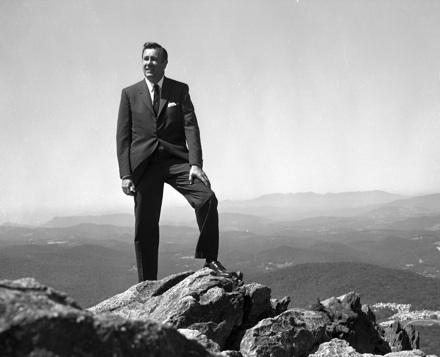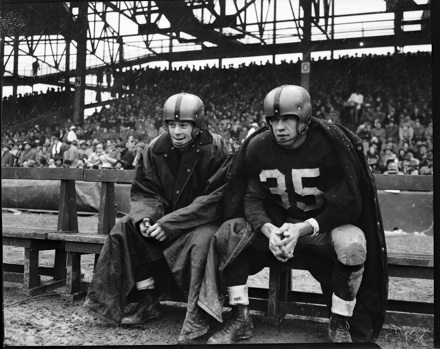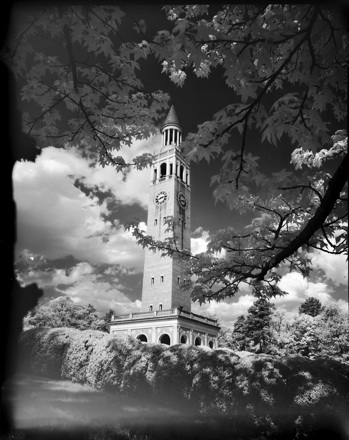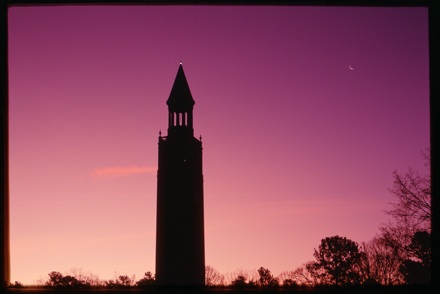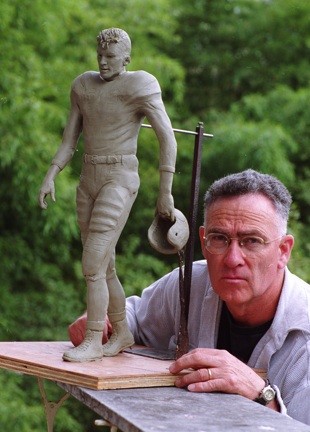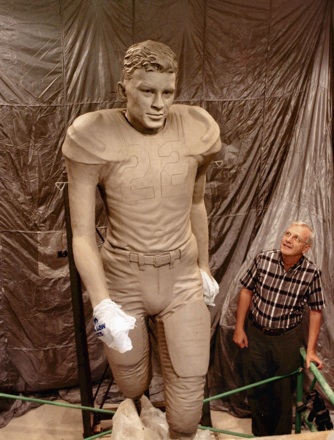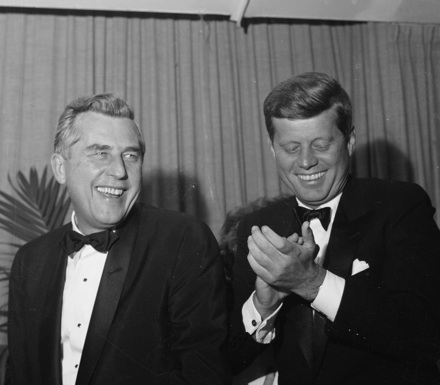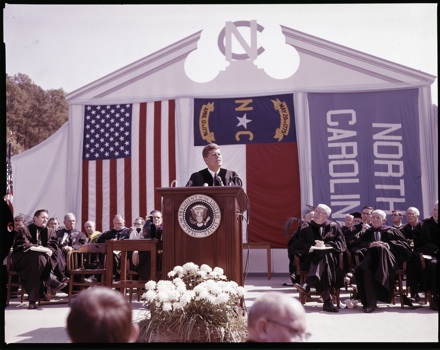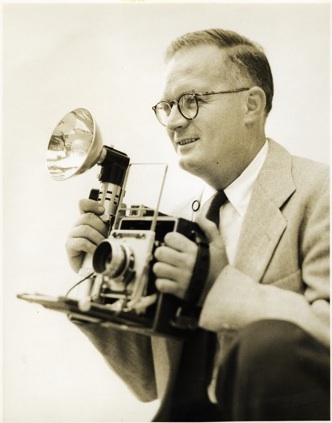Many news outlets have been reporting the death on Tuesday of pioneer televangelist Oral Roberts. You probably know some of the more interesting and controversial stories about Roberts, including his claims of being able to raise people from the dead and of receiving visions from a 900-foot Jesus; or his famous 1987 fundraising stunt where he told viewers that unless he raised $8 million, “God would ‘call him home.'” (He raised $9.1 million).
But you may not have known that Roberts made at least a few visits to Grandfather Mountain, NC, most notably as a speaker at the 1976 “Singing on the Mountain” gospel festival. Roberts shot a nationally-televised prime time special at Grandfather that year, featuring Roy Clark (among others).
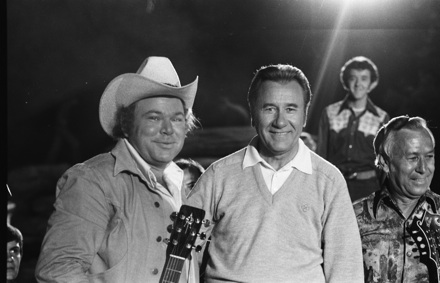
Roberts apparently enjoyed the golfing opportunities afforded by the Grandfather Golf and Country Club (if you look very closely at the image above, you can see he’s wearing a “GGCC” sweater). One fall visit, Roberts got a personalized Hugh Morton tour of the natural wonders of the area. According to Julia Morton, “Mr. Roberts came to Linville to visit a friend of ours from Tulsa. Rain kept him from playing golf so Hugh entertained him by showing him the countryside.” It was during this visit that Morton took the lovely portrait of Roberts below.
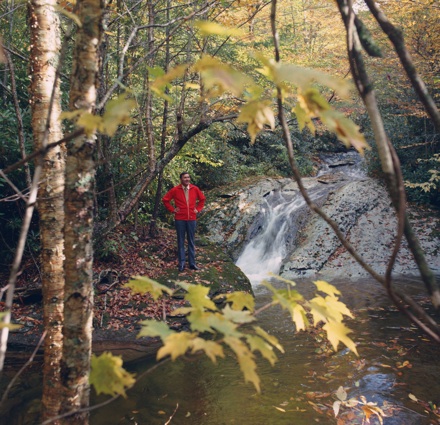
Elizabeth Hull
"Scores, Weather and Traffic, Up Next"
Note from Elizabeth: Hope you enjoy another great sports post from Morton volunteer Jack Hilliard!
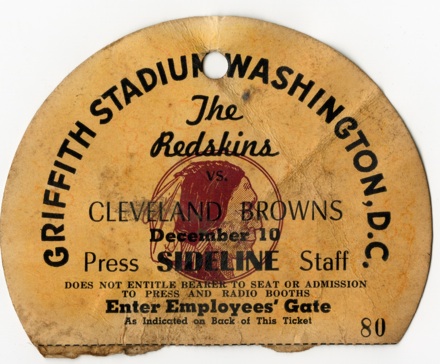
The Sunday afternoon weather forecast for Washington, DC and northern Virginia was for cold temperatures with sleet and snow. But that didn’t keep several thousand North Carolinians and Hugh Morton away from the Washington Redskins-Cleveland Browns football game in Griffith Stadium on December 10, 1950. Most of those Tar Heels were there to see UNC’s great All America Charlie “Choo Choo” Justice work his magic one more time. Morton was also there to see his friends Cleveland Quarterback “Automatic” Otto Graham, Redskins Halfback “Bullet” Bill Dudley, and Amoco Redskins Network announcer Harry “The Whiz” Wismer.
Before the scheduled 2PM kickoff, the snow began falling.
It was the final game of the ’50 season and for Justice it was the completion of his first season of professional football. Cleveland was favored to win (they were 9 and 2 while the Redskins were 3 and 8). A season-high crowd of 32,000 watched the Redskins take the lead in the first quarter when Justice caught a touchdown pass from Sammy Baugh. Both teams alternated in scoring the first six of the game’s nine touchdowns with the Redskins striking first each time. At times the snowfall was so heavy, it was hard to see the players, especially the Browns who were wearing their white uniforms. Luckily, the weather didn’t prevent the halftime show.
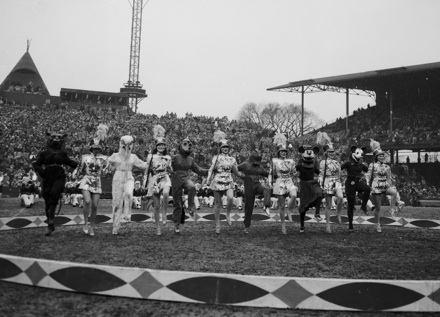
Continue reading “"Scores, Weather and Traffic, Up Next"”
Morton project awarded NCHC grant
 We’ve just gotten some exciting news! I’m pleased to share that the North Carolina Collection has been awarded a grant by the North Carolina Humanities Council to support a web publishing project entitled Worth 1,000 Words: Essays on the Photographs of Hugh Morton. The grant funds will be used exclusively to hire a group of scholars and writers to produce thirteen essays (1,000-1,500-words long, based on 3-5 images), highlighting some of the predominant themes represented in the Hugh Morton photographic collection. The essays will be published online as part of this very blog, A View to Hugh. The plan is for a new essay to be posted approximately bi-weekly between January and July, 2010.
We’ve just gotten some exciting news! I’m pleased to share that the North Carolina Collection has been awarded a grant by the North Carolina Humanities Council to support a web publishing project entitled Worth 1,000 Words: Essays on the Photographs of Hugh Morton. The grant funds will be used exclusively to hire a group of scholars and writers to produce thirteen essays (1,000-1,500-words long, based on 3-5 images), highlighting some of the predominant themes represented in the Hugh Morton photographic collection. The essays will be published online as part of this very blog, A View to Hugh. The plan is for a new essay to be posted approximately bi-weekly between January and July, 2010.
We think that the essays produced through the Worth 1,000 Words project will greatly enhance the discoverability of the collection, providing historical and cultural context and analysis of Hugh Morton’s fantastic images, while also demonstrating the value of visual resources for research and education. From the very beginning, we envisioned this project as interactive, hoping to take full advantage of the blog format. Our authors will not be writing into a void — you, as readers, will be able to comment, respond, object, ask questions . . . instead of just sitting there as static documents, the essays will provide jumping-off points for conversation, reflection, and exploration of our state’s culture and history.
We are thrilled that the Humanities Council has agreed to support this somewhat non-traditional publishing project, and would like to take this opportunity to express our appreciation to them!
View a list of essay authors and topics after the jump.
Continue reading “Morton project awarded NCHC grant”
"The sweet music of those bells…"
Note from Elizabeth: Thanksgiving Day marks the 78th anniversary of the dedication of UNC-Chapel Hill’s Morehead-Patterson Bell Tower. Morton Collection volunteer Jack Hilliard explores the Bell Tower’s history below.
Late summer 1947 . . .”It was a dark and stormy night.” Hugh Morton had set up his camera down the street from the Morehead-Patterson Bell Tower to photograph the University landmark during a thunderstorm. Little did he know at the time that one of the photographs from that session would wind up on the cover of two prominent North Carolina magazines simultaneously. That shot of the Tower (above), shrouded in haze with lightning flashing above, would be featured on the front cover of The Alumni Review issue of October, 1947, as well as The State magazine for October 25, 1947.
Over the years the Tower became a favorite photographic subject for Morton. His Bell Tower shots graced the cover of The State at least two more times, February 25, 1950 and January, 1974.
In the early 1920s John Motley Morehead III proposed the idea of a Bell Tower to UNC President Harry Woodburn Chase. As part of the post-World War I building boom on campus, South Building was remodeled and Morehead suggested putting a bell tower on top of the building. The University “powers that be” wanted to maintain the historical integrity of the old structure, so they declined the offer. Then, in 1926, the administration drew up preliminary plans for what would become Wilson Library. Again, Morehead offered to pay for a bell tower on top of the library, but University Librarian Louis Round Wilson had already decided that “his” building would be domed.
Later, when University trustees moved the flagpole from McCorkle Place to Polk Place, Morehead again suggested a bell tower, and again the administration declined his offer. At this point Morehead enlisted the help of Rufus Lenoir Patterson II, prominent New York businessman, and the two families, along with University officials, came to an agreement that the Bell Tower would be placed between Wilson Library and Kenan Stadium.
On Thanksgiving Day, November 26, 1931, Governor O. Max Gardner delivered the acceptance address, concluding with these words:
I dedicate this tower and the sweet music of these bells to the future upbuilding of this institution and this state, knowing full well that on this campus the sons of North Carolina will be inspired by the harmony of these chimes and will here catch the vision and follow the gleam.
Later that afternoon, as was the Thanksgiving tradition in those days, Carolina played Virginia in Kenan Stadium.
Originally the bells were rung manually, but now the 14-bell carillon operates electronically, and has been heard as far away as Durham. The largest bell, which tolls the hour, is engraved with the name of Governor John Motley Morehead, grandfather of the bell’s creator.
The 172-foot Morehead-Patterson Bell Tower actually rises about 200 feet, since it is built on a knoll, and it is surrounded by a hedge and lawn designed by William C. Coker, botany professor and creator of the campus Arboretum.
The photograph on page 94 of Morton’s 2006 book, Hugh Morton: North Carolina Photographer, shows the Morehead-Patterson Bell Tower at sunset—the way it often looks as it serenades the dispersing crowd after a great Tar Heel victory in Kenan, like the 13 to 6 win on Thanksgiving Day 1931.
—Jack Hilliard
Series 2 (People & Events) available!
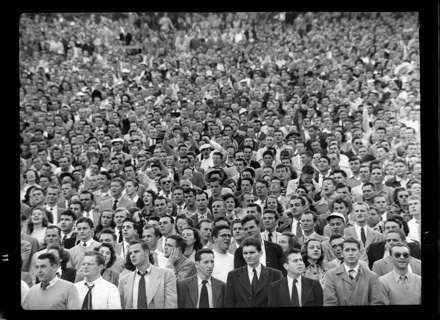
You knew Hugh Morton photographed legendary North Carolinians including Terry Sanford, Michael Jordan, Billy Graham, Andy Griffith, and Charles Kuralt; Azalea Queens and musicians of all stripes; and prominent national figures from John F. Kennedy to Al Gore. You definitely knew that he photographed Luther H. Hodges (NC Governor 1954-1961, and likely Morton’s most-photographed person, except for perhaps his family).
But, did you also know that Morton photographed both the Prince of Wales and Queen Elizabeth II? What about Ed Sullivan, or Rich Little? Jesse Jackson, Coretta Scott King, and Shirley Chisholm? And how about Newt Gingrich with a black bear? (A die-hard Democrat himself, Morton did in fact take pictures of some Republicans — Gingrich, Reagan, Nixon, and Helms, to name a few). Did you know he took striking portraits of rural people living in the NC mountains during the 1940s-1950s? And shot at least four different Cherokee Chiefs?
This is just a tiny morsel of the feast of riches that await you in Series 2 of the Morton Collection, now included in the online finding aid and available for in-person exploration. This is the largest series (oh, how I hope) and definitely the most difficult to process — take note that subseries 2.6, “People, Identified,” contains more than 700 different named individuals!
Take a look, and — as always — give us your feedback on what/how we’re doing.
My Personal "Photo By Hugh Morton"
Note from Elizabeth: Five years ago today, Johnpaul Harris’ sculpture of UNC football legend Charlie “Choo Choo” Justice was unveiled at the west entrance to Kenan Stadium. Not only was our volunteer Jack Hilliard there, he was involved (along with Hugh Morton) in the creation of the statue. Jack shares some of his recollections in this post.
The voice on the phone was familiar. “Hello Jack, this is your friend Hugh Morton.” He was answering my request for photographic help with one of my projects. The conversation lasted about 10 minutes but as we began to wrap it up Hugh said: “I’m going to be dong something next Tuesday that you might be interested in. I’m going to take a group of Justice-era players over to Johnpaul Harris’ studio in Asheboro to check out his progress on the Justice statue. Would you like to join us?” It took me about 1/100 of a nanosecond to make up my mind. We were all to meet at the McDonald’s on Highway 64 in Asheboro at 10 on Tuesday morning June 1, 2004. “We’ll caravan over to the studio . . . I can take you there, but couldn’t begin to tell you how to get there,” he said.
When I walked into the restaurant on Tuesday morning it was like a gathering of my boyhood heroes . . . Rizzo, Neikirk, Morton, Pupa, and Cox. A few moments later Weiner joined the group. Boyhood heroes indeed, but the thing is, I never outgrew that . . . these guys are still my heroes.
The 10 mile drive to Harris’ studio took about 15 minutes—Highway 64 to 49 and back into rural Randolph County. Johnpaul and Ginger Harris’ home/studio is unique. (It was once described in a magazine article as a cross between “Swiss Family Robinson” and “Sanford and Son”). We were greeted and taken in to view the 8 foot 6 inch clay model. All of the Justice-era players made comments and Harris took lots of notes. Then Morton took out his camera and began taking pictures. When all of the players’ pictures had been taken, he turned to me and said, “OK, Jack, let’s get one of you.” It was like that Walter Cronkite – Ted Baxter scene from the Mary Tyler Moore Show when Cronkite tells Baxter, “you can call me Walter.” I wasn’t dressed properly for a picture, but I wasn’t about to miss the opportunity to have a my very own personal “Photo by Hugh Morton.” When that photo arrived in the mail a couple of days later, it was placed in a very special scrapbook to be treasured forever.
Over the next five months I made several trips back to the studio to watch a master at work, and in the process Johnpaul and Ginger became great friends. In early September a statue dedication date was finalized.
Continue reading “My Personal "Photo By Hugh Morton"”
Morton digital collection update
The Morton digital collection has now surpassed 2,000 items! (This 1960 image of John F. Kennedy and New Jersey Governor Robert B. Meyner just happened to be the 2,000th image added — I like to think they are applauding our efforts).
Want to be alerted as additional Morton photos are uploaded/updated? You can now “subscribe” to the Morton collection via an RSS feed. Note that you will need to have an account with a “feed reader,” such as Google Reader or Bloglines, to use the service. You’ll probably also have to clear out a few rounds of images that are not actually new to the collection, but are new to your reader. Once you’re up-to-date, you’ll only see those that are being newly added or updated.
Speaking of which — since launching the digital collection, we have received 165 comments, almost all of which have contained useful identifying information for Morton photographs in the digital collection. While that’s definitely A LOT, the comments have come from a very small number of people. We want to hear from you! Search or browse the collection by name, location, subject, or decade, then click on “feedback” at the top of the item page to share your knowledge.
‘Rubbing Shoulders With History’
Note from Elizabeth: Today is University Day here at UNC-Chapel Hill, the oldest state university in the country. To help us celebrate, volunteer Jack Hilliard remembers some University Days past. (Further recollections of the Kennedy event and the full text of his speech can be found on the fabulous Chapel Hill Memories blog).
The TV viewing room on the first floor of Teague Dorm at UNC was small, but a dozen or so of us crowded our way inside. We had come to watch a speech by President John F. Kennedy, one that would be extremely important to several of us who were scheduled to graduate in less than six months. It was October 22, 1962, and we were being “recruited” by the big four—not Carolina, Duke State, and Wake, but the other big four—Army, Navy, Air Force, and Marines. As I sat waiting for the address, my mind wandered back to one year and 10 days before, when I sat waiting for this same President to speak.
October 12, 1961 was a beautiful fall day in Chapel Hill. About 32,000 of us had gathered in Kenan Stadium to observe University Day 1961 — the University’s 168th birthday. The highlight of the morning was an address by President John Kennedy, scheduled for 11 AM. Thirty minutes before the President arrived, the official 40-person White House Press Corp arrived and joined the local media in scrambling for good viewing positions. Among those scramblers was a man who had covered University events for more than 20 years: Hugh Morton.
At 11:05 AM, President Kennedy’s caravan arrived at the west end of the stadium, having completed a journey down Highway 54, which had been closed and well guarded by 50 North Carolina Highway Patrolmen. The President, with Governor Terry Sanford at his side, rode in an open top limousine. At 11:12, the academic procession, led by Faculty Marshal John Coriden Lyons, started toward the east end of Kenan Stadium. Greensboro Record staff writer Charlie Hamilton described what he saw:
“A warm sun whose heat was cooled intermittently by soft breezes, beat down upon the scene, as the President, in cap and gown and flanked by state, national, and university officials, made his way beneath the west goal post and down the gridiron to the speaker’s rostrum.”
UNC's J-School celebrates 100 years
Though September 9 was the official 100-year anniversary of the first class offered by the School of Journalism and Mass Communication at UNC-Chapel Hill, celebrations and events continue to mark this milestone for one of the country’s best-regarded journalism programs. One such event is an exhibit currently on display here in Wilson Library’s North Carolina Collection Gallery, Consecrated to the Common Good, which features the above photo of Hugh Morton (as well as other notable alumni including W. Horace Carter).
Morton’s legacy is alive and well at the J-School thanks to the Hugh Morton Distinguished Professorship established by his wife Julia to help the school recruit or retain an outstanding educator and provide scholarly, research or instructional support for that person. Julia Morton is quoted in an article on the Carolina Development website as saying:
“My main purpose for establishing this professorship is because there really is no other ‘watchdog’ standing between the citizens of North Carolina and Raleigh and Washington, so it’s important that today’s journalism students know how to ask the hard questions,” Julia Morton said. “What’s more, I can think of no better way to honor Hugh than to enable others to experience and appreciate what he held dear—Grandfather Mountain, the state of North Carolina and the UNC experience.”
We hope you can join us in the Gallery next Thursday, October 15 at 5pm for a reception and exhibit viewing, to be followed by a lecture by Tom Bowers, J-School professor emeritus and author of Making News: One Hundred Years of Journalism & Mass Communication at Carolina.
Who is Singleton Anderson?
This is a question I was asking myself from the time I started working on the Morton collection until recently, when I happily discovered the answer. A particular batch of Morton negatives labeled “Singleton C. Anderson, Rocky Pt.” caught my attention when I was making my first survey of Morton’s photographs. I noticed them because 1) they were striking black-and-white images from the circa 1950 period, and 2) they depicted African Americans in a non-athletic setting (somewhat unusual in Morton’s work).

Some quick Google searches at the time were fruitless; I suspected the images showed scenes from a Rosenwald School, but I didn’t have time to look into it any further. But the images, and Anderson, stuck with me. I just had a feeling they were important. So when I came upon them again recently during processing, I figured “what the heck,” and tried another Google search. Jackpot!
The site I found, Under the Kudzu, is run by educator and writer Claudia Stack, who is now in the process of creating a feature-length documentary film focused on the Rosenwald school movement as shown through two schools in Pender County, NC: the Canetuck Rosenwald School, a primary school, and the Pender County Training School, a high school. PCTS was located in, yes, Rocky Point. I emailed Claudia immediately and attached jpegs of the images included in this blog post. The next day, I got this reply:
I am ASTOUNDED at these images . . . I have been researching PCTS and Singleton C. Anderson’s profound impact on the region for the past six years, but images are very hard to come by. That is partly, I think, because he was a humble man, and partly because a tragic house fire claimed the life of his wife, Vanetta Anderson, and also all of their papers and pictures.
So, who in fact WAS Singleton C. Anderson?

